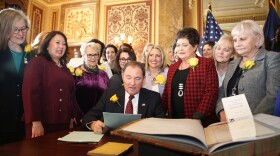Tuesday marked the 100th anniversary of women’s right to vote in the United States. But that right came much earlier in the Mountain West.
Wyoming was just a territory when it started letting women vote in 1869, which led to a cascade of other Western states allowing the same. Outside of New Mexico, every territory and state in the West allowed women to vote before the 19th Amendment.
That wasn’t because western states like Wyoming felt women deserved this right, though. It was a time of rapid Westward expansion, and Wyoming had barely been able to become a territory in 1869.
“That was because of the boom of the transcontinental railroad, which is going across,” said Virginia Scharff, distinguished professor emeritus at the University of New Mexico and senior scholar at the Autry Museum of the American West.
She says that was a “way that the United States was trying to say, let’s get this place organized as a territory...get white settlement into there and unsettle the Native People who live there.”
Territories like Wyoming wanted more white settlers, so they figured they could bring more white women out by allowing them to vote.
“Long story short, if they could get white women out here, white men would be more likely to settle down,” Scharff said.
She added that these laws were exclusively aimed at white women. One lawmaker in Wyoming even tried to sink the bill by adding in wording that explicitly gave voting rights to women of other races. But his amendment failed “because everybody said ‘look we know we’re only talking about white women here.’”
After Wyoming’s passed the law, states around the West saw it as an opportunity for them, too. And interestingly, even though Wyoming was the first to grant women’s suffrage, Utah was the first place where women cast a vote because their elections came first.
Scharff said it’s good to note that the 19th Amendment was an important part of women’s suffrage, but there’s a lot more to the story, especially for the suffrage of female people of color.
“Really the bottom line is colonialism and white supremacy kind of combined to create ideal conditions under which this women’s suffrage law could pass,” she said.
Some western states are still leading the way for women’s representation, with Nevada becoming the first legislaturewhere women have majority control.
Those gains aren’t across the board, though. Wyoming’s legislature still has some of the nation’s least female representation with only 15.6% in 2019, though its sole Congressional representative is female.
This story was produced by the Mountain West News Bureau, a collaboration between Wyoming Public Media, Boise State Public Radio in Idaho, KUNR in Nevada, the O'Connor Center for the Rocky Mountain West in Montana, KUNC in Colorado, KUNM in New Mexico, with support from affiliate stations across the region. Funding for the Mountain West News Bureau is provided in part by the Corporation for Public Broadcasting.
Copyright 2020 Boise State Public Radio News. To see more, visit Boise State Public Radio News.






